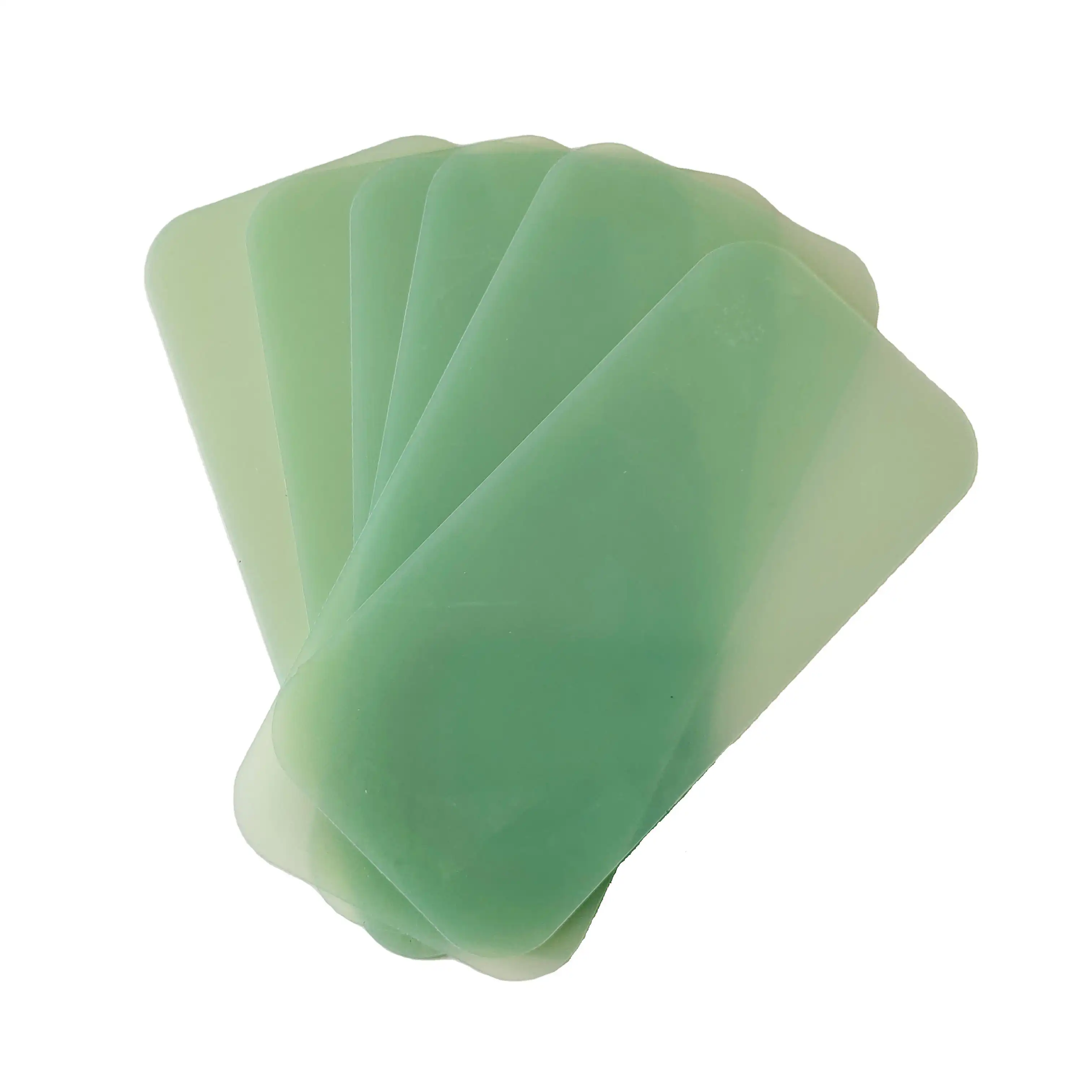What Are the Key Properties of G10 Epoxy Sheet?
Mechanical Strength and Durability
G10 epoxy sheets boast remarkable mechanical strength, rendering them suitable for demanding industrial applications. Their high tensile strength, typically ranging from 40,000 to 65,000 psi, enables them to withstand significant loads without deformation. This robustness is complemented by exceptional impact resistance, allowing G10 components to endure repeated stress and vibrations commonly encountered in industrial environments. The material's durability is further enhanced by its low moisture absorption rate, typically less than 0.1%, which helps maintain its structural integrity even in humid conditions.
Electrical Insulation Properties
One of the most valued attributes of G10 epoxy sheets is their superior electrical insulation capabilities. With a dielectric strength exceeding 800 volts per mil, these materials provide excellent protection against electrical breakdown. Their low dielectric constant and dissipation factor contribute to minimal energy loss in high-frequency applications. Moreover, G10 epoxy sheets maintain their insulating properties across a wide temperature range, making them ideal for use in electrical components subjected to thermal cycling.
Thermal and Chemical Resistance
G10 epoxy sheets exhibit remarkable thermal stability, retaining their mechanical and electrical properties at temperatures up to 130°C (266°F). This thermal resistance is crucial for industrial equipment operating in high-temperature environments. Additionally, these materials demonstrate excellent chemical resistance, withstanding exposure to various solvents, oils, and corrosive substances without degradation. This characteristic ensures longevity and reliability in applications where exposure to harsh chemicals is inevitable.
Mechanical and Electrical Performance in Harsh Environments
Resistance to Extreme Temperatures
In industrial settings where equipment is exposed to extreme temperatures, G10 epoxy sheets prove their mettle. These materials maintain dimensional stability and mechanical strength across a wide temperature spectrum, from cryogenic conditions to elevated temperatures. Their low coefficient of thermal expansion minimizes warping and distortion, ensuring precise fit and function of components even under thermal stress. This thermal resilience is particularly valuable in industries such as aerospace, where materials must perform reliably in both sub-zero and high-temperature environments.
Withstanding High-Pressure Conditions
G10 epoxy sheets exhibit exceptional performance under high-pressure conditions, a critical requirement in many industrial applications. Their high compressive strength, often exceeding 65,000 psi, allows them to resist deformation and maintain structural integrity even when subjected to intense pressure. This property is particularly advantageous in hydraulic and pneumatic systems, where components must withstand cyclical pressure loads without fatigue or failure. The material's ability to maintain its dimensional stability under pressure contributes to the overall reliability and longevity of industrial equipment.
Resistance to Corrosive Environments
Industrial equipment often operates in corrosive environments, where exposure to chemicals, moisture, and other aggressive agents is common. G10 epoxy sheets demonstrate remarkable resistance to corrosion, maintaining their mechanical and electrical properties even when exposed to harsh chemicals and saltwater. This corrosion resistance is attributed to the material's low moisture absorption and chemical inertness. As a result, G10 components can be employed in marine applications, chemical processing plants, and other corrosive environments without compromising performance or requiring frequent replacement.
Common Industrial Equipment Utilizing G10 Epoxy Sheets
Electrical and Power Distribution Systems
G10 epoxy sheets play a crucial role in electrical and power distribution systems, where their excellent insulating properties and mechanical strength are highly valued. These materials are extensively used in the fabrication of switchgear components, such as busbar supports, arc chutes, and insulating barriers. In transformer manufacturing, G10 sheets serve as core insulation, winding spacers, and end frames, contributing to the overall efficiency and reliability of power distribution networks. The material's ability to withstand high voltages and maintain dimensional stability under thermal stress makes it indispensable in the production of circuit breakers and other high-voltage equipment.
Aerospace and Aviation Components
The aerospace industry relies heavily on G10 epoxy sheets for various applications due to their exceptional strength-to-weight ratio and resistance to extreme conditions. These materials are utilized in the construction of aircraft interior panels, flooring, and structural components, where their lightweight nature contributes to fuel efficiency without compromising strength. G10 sheets also find application in avionics enclosures, where their electrical insulation properties and dimensional stability ensure the reliable operation of sensitive electronic equipment. In addition, their resistance to moisture and chemicals makes them suitable for use in fuel system components and hydraulic manifolds.
Industrial Machinery and Equipment
G10 epoxy sheets are widely employed in the manufacture of industrial machinery and equipment across various sectors. In the textile industry, these materials are used to produce loom components, such as picker sticks and shuttles, where their wear resistance and dimensional stability are crucial. The food processing industry utilizes G10 sheets in the fabrication of conveyor components and cutting boards, taking advantage of their non-toxic nature and resistance to moisture absorption. In the automotive sector, G10 materials find application in the production of gaskets, seals, and electrical insulation components, contributing to the overall performance and longevity of vehicles.
Conclusion
G10 epoxy sheets have revolutionized the landscape of industrial equipment manufacturing, offering a unique blend of mechanical strength, electrical insulation, and chemical resistance. Their versatility and exceptional performance in harsh environments make them indispensable across various sectors, from electrical power distribution to aerospace and industrial machinery. As industries continue to evolve and demand more robust and reliable materials, G10 epoxy sheets are poised to play an increasingly vital role in shaping the future of industrial equipment design and performance.
FAQs
What is the maximum temperature G10 epoxy sheets can withstand?
G10 epoxy sheets typically maintain their properties up to 140°C (284°F).
Are G10 epoxy sheets suitable for marine applications?
Yes, due to their corrosion resistance and durability in harsh environments.
Can G10 epoxy sheets be machined easily?
Yes, they can be cut, drilled, and shaped using standard machining tools.
What is the typical lifespan of G10 epoxy sheets in industrial applications?
With proper use and maintenance, G10 sheets can last for decades in many industrial settings.
Are G10 epoxy sheets environmentally friendly?
While not biodegradable, their long lifespan and potential for recycling contribute to sustainability efforts.
Experience the Superior Quality of J&Q's G10 Epoxy Sheets for Your Industrial Equipment Needs
J&Q, with over two decades of expertise in manufacturing and supplying insulating sheets, offers premium G10 epoxy sheets tailored for diverse industrial applications. Our global presence and extensive experience in foreign trade ensure unparalleled product quality and customer service. Benefit from our integrated logistics solutions for a seamless experience. For more information about our G10 epoxy sheets and other insulating materials, contact us at info@jhd-material.com.
References
Smith, J. (2021). Advanced Composites in Industrial Applications: A Comprehensive Guide.
Johnson, R. et al. (2020). Electrical Insulation Materials for High-Voltage Equipment.
Brown, L. (2019). Thermal Management in Aerospace: Materials and Methods.
Taylor, M. (2022). Corrosion Resistance of Composite Materials in Industrial Settings.
Wilson, K. (2018). High-Performance Plastics in Power Distribution Systems.
Davis, E. (2023). Sustainable Materials for Next-Generation Industrial Equipment.






